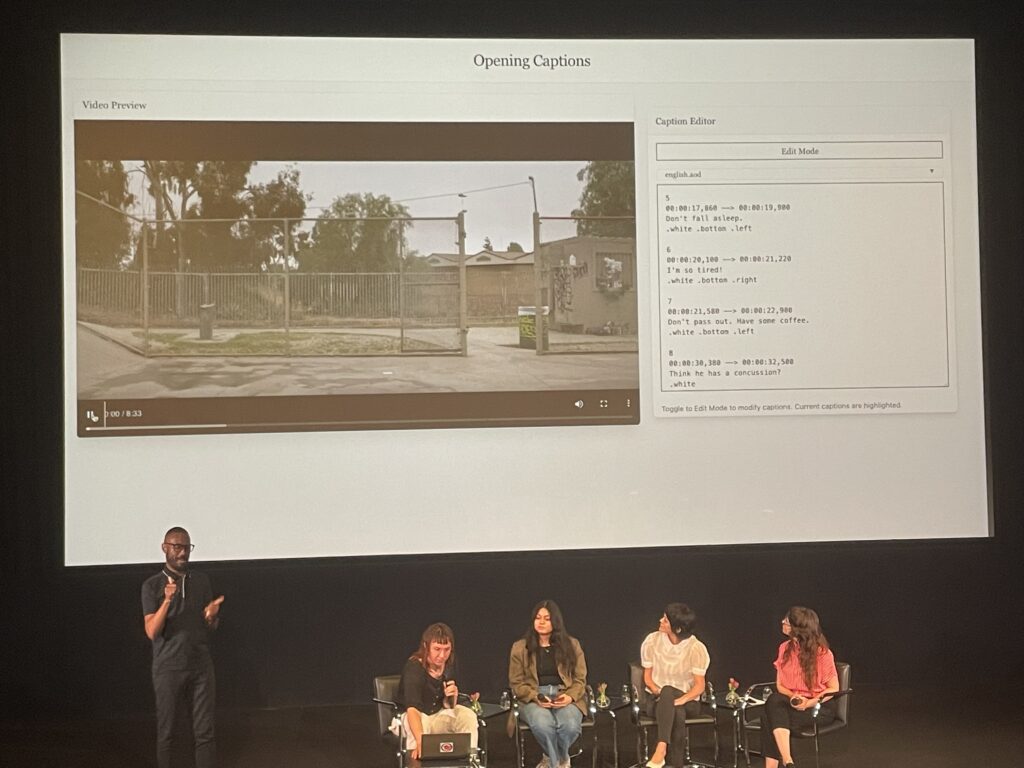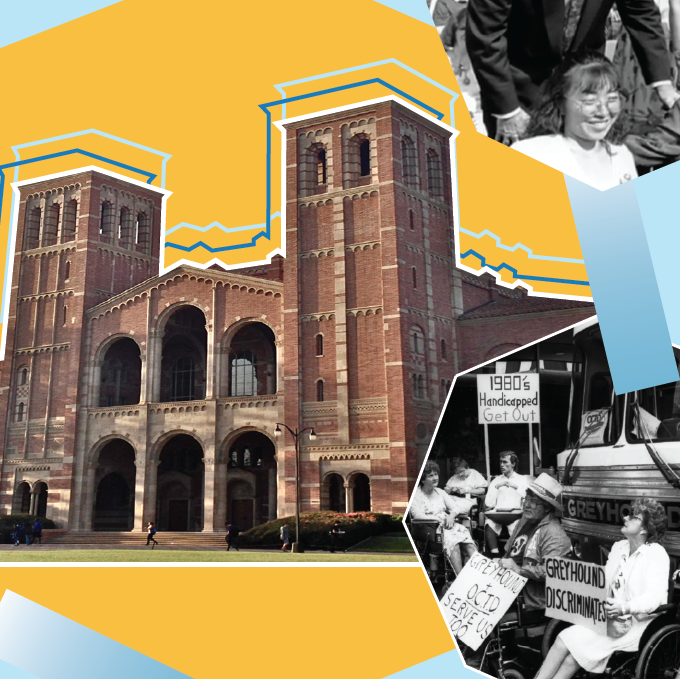On March 20, 2025 at the Hammer Museum, d/Deaf visual artist Alison O’Daniel screened a selection of her films over the years, demonstrating the evolution of her use and exploration of open captioning. Although captions are made for accessibility for d/Deaf and Hard of Hearing audiences, they often do not acknowledge the film-watching experiences of deaf audiences. Alison shared her hopes that captioning can address the complexity and richness of the film experience and involve both hearing and d/Deaf/Hard of Hearing audiences for a more complete viewing experience. The conversation following the screenings focused on Alison’s partnership with UCLA Disability Studies and UCLA Social Software (SoSoft) to create a tool called Opening Captions that expands the possibilities of captioning technology.
Alison shared excerpts from two groups of films. The first three excerpts were from The Tuba Thieves, her feature-length film. Working with Deaf artist and performer Christine Sun Kim on a scene in The Tuba Thieves, Alison meticulously jotted down notes to direct Christine to recreate the sounds she had made and came to realize her perspective as a hard of hearing person could be valuable in drafting descriptive, precise captions for d/Deaf audiences. In the scene, Christine performs the English script in ASL while Steve Roden voices over the performance, reading Christine’s teleprompter notes for herself. Hearing the teleprompter notes brings the audience deeper into the performance by revealing a side that is often reserved for the performer. The combination of translation from English to ASL and the performance of the written descriptions made clear the level of detail and meaning that can be lost without descriptive captioning.
The second group of excerpts were from two films that Alison had the privilege of captioning and that are significant to the representation of the d/Deaf community in film: Compensation (1999) and Marlee Matlin: Not Alone Anymore (2025).
Compensation follows the parallel lives of two Deaf Black women that fall in love with hearing men and their struggles with structural racism, pandemics, and social forces of their respective time periods, the early and late 20th century. Alison showed two clips from Compensation, newly restored in 4K in 2024. In one of the comedic scenes, the character Malaika rolls her eyes and scoffs as her lover Nico, a hearing man, shares his desire to make love by attempting to sign in ASL with incorrect or misspelled signs. She signs that she has a yeast infection and shrugs him off. Persistent, he struggles with the ASL grammar to convey his message. Alison takes time to caption his spelling mistakes and lets hearing audiences in on the joke. By acknowledging the mistakes, all viewers understand the scene more completely.
In another scene, Alison plays with the descriptions of the fantastic and abstract sound design of the film. As a train barrels by, captions describing the sound jump and appear and disappear in varied ways. In one instance, the same word is displayed three times in a vertical stack to show the layered noise. In other instances, captions are placed in unique shapes that draw the eye or capitalized and spaced out to show the expansiveness and volume of the noise. Alison also describes the literal source of the noise while vividly describing the sharp, metallic, clanging sounds. These are some ways that Alison experiments with captioning. Alison’s captioning work reimagines how captions can be used. The captions are a poetic and deep accompaniment to the film, creating a more holistic viewing experience.
Each of these film selections brilliantly demonstrated how captions differ from subtitles. Whereas subtitles are meant for hearing audiences and translate the language from one to another, captions are designed for d/Deaf/Hard of Hearing audiences and provide a textual description of the sounds effects, dialogue, and music. Proposing total access for dDeaf/Hard of Hearing/etc., open captions are burned into the image, as opposed to Closed Captions that can be turned on or off by the viewer. Arguably, captions not only add to, but complete the viewing experience for everyone.
Following the screenings, Alison invited the team from UCLA to discuss their partnership and the development of the Opening Captions tool. The partners included Lauren Lee McCarthy, Professor of UCLA Design | Media Arts, UCLA Disability Studies and Co-Director Social Software, Stalgia Grigg, artist, programmer, and software engineer on Opening Captions, and Tanya Cortez, UCLA Design | Media Arts major and intern on the project.
When approached by Professor Lee about the partnership, Allison knew that this opportunity would support her goal to simplify captioning for all film makers globally. She had spent up to nineteen hours editing thousands of captions by hand while she was touring The Tuba Thieves at film festivals like Sundance back in 2023. The added manual labor for the sake of accessibility took time away from opportunities to fully participate in the festival. Making a way to edit captions faster could open up opportunities for filmmakers to do more filmmaking and allow them to include captions as part of the filmmaking process from the start by removing the technical barriers to creating and editing the captions.
Software engineer, Stalgia Grigg, demonstrated the tool. The Opening Captions software allows users to edit not only text and timing information, but also style information – color, size, placement, and animation – very simply. In addition, this new file format is portable which allows users to make quick changes without proprietary knowledge of other film editing software. The dream is to pioneer this file format and make it an industry standard. This would make it much easier for artists and filmmakers to style their captions and translate them for a wide range of screening platforms.

Tania Cortez, DMA student and intern, had the opportunity to share her research and involvement in the project on the international regulations surrounding captioning. Opening Captions can be further developed to allow for different captioning regulations from around the world. For example, Slovakia has a specific color coding system for captions versus the United States. In addition to translating the captions into another language, quickly changing captions to another country’s color regulations would allow for easier global distribution of the film.
The event concluded with a special preview of Alison’s latest work-in-progress titled A Disaster. In this experimental script, Alison explores the concept of “sonic warfare” – the weaponization of sound – to illustrate a way that ableism can be a disastrous daily battle against people with disabilities. For about eight minutes, text appears and disappears on a black screen in this “script film.” The first half of the film is about Havana syndrome, the mysterious illness characterized by severe headaches, dizziness, blurred vision, tinnitus, and vertigo, usually following a loud noise and intense pain in the ears and head. Silent until the very end, the film then shows video footage of a protest on March 18, 2025 in Belgrade, Serbia, where a sonic cannon was allegedly used on protesters.
In the subsequent Q&A portion, Alison elaborated upon her future projects, shared her favorite representations of d/Deaf and Hard of Hearing people in films by hearing people, and her experience navigating the US requirements on captioning.
Alison O’Daniel’s The Tuba Thieves will be screening at the Academy Museum on June 26, 2025.


